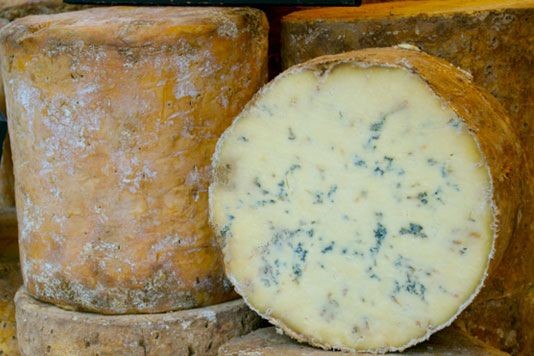Guide to British blue cheese

Beyond our trustworthy stilton there's a whole plethora of British Blue cheeses. Here we take a look at some of the UK's finest.
Our cheese culture (excuse the pun) here in the UK is a proud and well respected one. From small artisan producers to large and established dairies, we make some of the best cheeses in the world and certainly some of the most interesting. Here we turn our attention to British blue cheese. I’m sure we’ve all encountered Stilton and whether from Colston Bassett or Cropwell Bishop, it is a champion of British cheese making, but beyond this famous blue there are many other interesting styles. Venture forth and procure yourself some of these amazing cheeses, the blue veins are beckoning.
Beenleigh Blue
“If I had to choose the single luxury item I could take to a desert island, as on the BBC radio program Desert Island Discs, my choice would be Beenleigh Blue.” Writes Bob Farrand in The Cheese Handbook. Beenleigh Blue is made from unpasturised sheep’s milk and is only available during Autumn and Winter months as the producer refuses to use frozen milk whilst the ewes are lambing. Look out for this sweet creamy fresh cheese. It makes a fine cornerstone to a cheeseboard.
Dorset Blue Vinny
In 1980, Mike Davies resurrected an extinct cheese in Dorset. Made to a three hundred year old recipe, Dorset Blue Vinny is made from unpasturised cows milk and vegetarian rennet. Traditionally, old anchors and chains would be pulled through the milk to encourage the blue veins in the cheese. Fortunately, this element of the cheese making process is left out. Dorset Blue Vinny is a gentle blue with a mild sweetness. A fantastic blue for cooking with.
Stichelton
Stichelton, is a creamy blue cheese made to a similar recipe to the PDO protected Stilton. The main difference is that Stichelton uses unpasturised milk. Compared to Stilton, the cheese is richer and has a little more length of flavour. Having not been pasturised, the intricate flavours of the milk come through much more in this dense cheese and as such, the flavour profile changes with the seasons. Fresh and grassy notes when made from Spring milk and more earthy with a subtle hint of hay with Autumns milk.
Cornish Blue
Cornish Blue won Supreme Champion at the 2010 World Cheese Awards and Best British Cheese in 2011. The cheese is made in two different variations; one with vegetarian rennet and one with traditional animal rennet. This makes a significant difference in the cheese and it’s worth noting that it was the animal rennet version that took the awards. Cheese maker Philip Stansfield of Cornish Blue explains, “Not only do we get more yield of cheese with the animal rennet, but we can mature it for longer and because of that we get more flavour.”
Blue Monday
Fortunately, we have a strong contender to Roquefort here in the UK. Before Alex James started doing unsavoury and perverse things with cheese, he put his name to a blue cheese produced in Scotland under the Evenlode Partnership. Blue Monday, named after the song by New Order, is a 650g cube of blue cheese that has cavernous blue craters and veins throughout and carries a sweetness alongside the subtle salty twang.
So venture out beyond your trusted stilton, if only to a different producer. I’m sure the intricacies of blue cheese will keep you intrigued and once you get started, you’ll be hunting them down.
What’s your favourite blue cheese and how do you enjoy it? Let us know below.
Jose Pizarro's Roast pumpkin soup with blue cheese
Scooping the Stilton by Sophie Morris
Comments
Be the first to comment
Do you want to comment on this article? You need to be signed in for this feature